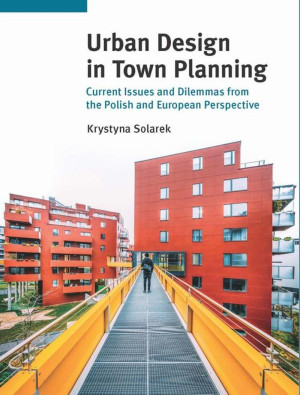
Urban Design in Town Planning. Current Issues and Dilemmas from the Polish and European Perspective
Producent: Oficyna Wydawnicza Politechniki Warszawskiej
Urban Design in Town Planning. Current Issues and Dilemmas from the Polish and European Perspective Krystyna Solarek Cities have become the habitat for more than half of the worlds population. Cities are not only a desirable location for life activities but also the subject of great interest, scientific research and social activities as well as everyday fascinations. However, it can be observed that the more we talk about cities and their planning - about sustainable development, eco-development, new technologies, smart cities, participatory planning and various new urban policies, etc., the less space there is to deal with the topic of urban design. Indeed, urban design will not solve all city problems, but one must be aware that all city problems will not be solved without urban design.
It is evident that city is as a complex, dynamic open system shows great possibilities of self-regulation and self-organization. However, people have been trying to influence this system for centuries through planning. The formation of certain rules and deepening knowledge of the functioning of urban organisms certainly contribute to improving quality, in this case the quality of life in cities. The organization is not an end in itself, but a tool for getting certain collective values. Town planners and urban designers, based on the broad knowledge they have, are probably the closest to achieving the assumed results (Mironowicz 2013).
Urban design as an occupation is relatively new, but historically it has usually played a significant role in forming cities. Urban design, although it did not have that name yet, has for centuries been one of the most important arts - the one that has most strongly affected the lives of successive generations that has survived to this day - whether in a transformed or unchanged form, or in memory and historical records.
In the simplest terms urban design is a link between architecture and spatial planning - a part of spatial planning with the basics and approach of architecture. This is a field where not all architects and few town-planners feel good and competent. It is art, technique, skill and process, as a result of which spatial structures are shaped. It gives them form, function and character approŹpriate to the scale of the study or document.
Urban designs, as the saved projects, no matter how long they were prepared, usually “last only for a moment. But this does not mean that they do not matter to the development of cities. On the contrary - they change into land development plans, strategies and action programs, or projects for the specific areas, sometimes they are only an inspiration or hint for municipal authorities, and at other times the basis for creating master plans or a picture that allows participants to check the ideas presented. Among the various projects or competition urban concepts, the possibility of implementation usually has one vision - the others remain the experience of the designers or an inspiration for those who had the opportunity to look at them. Despite the apparent elusiveness of this “being, which is the urban design, it has a key impact on the formation of spatial structure cities.
This book doesnt offer any detailed guideline of urban design, arranging the streets, squares and buildings that make up the public face of towns and cities. It is only to show how important it is to shape city structure using urban design, where it is possible, so as to build urban developments which are both structurally and functionally harmonious, logical, friendly, resilient, rational and... beautiful. This has been mans desire since the very beginning and today its important to recall this with the reflection on the role and range of urban design in the times of participatory culture of the information era.
The book is also intended to show where urban designs are the most useful today and what priorities can guide their creation if they are to be consistent with contemporary postulates. The study also draws attention to the biggest problems, difficulties and challenges that relate to design in the era of participation, parameterization, globalization and uncertainty. Most analyzes end with questions, although I try to answer some of them myself, without any certainty as to whether they are correct. The study also shows where, in a fascinating and broad urban theme, urban designers can find a place for themselves - how to translate new ideas and postulates for urban design.
I would like to draw attention to some current issues and dilemmas of urban design related to both new models of economic development, features and needs of contemporary societies, as well as new planning tools. The lack of creative foundations for regional planning, the disappearance of urban design in local planning, and the underestimation of urban design in the education of architects and town planners are particularly noticeable in Poland, but also visible in other countries. And yet temporary problems, also those related to the impediments to the implementation of
Sklep: gandalf.com.pl
Cena:
63.20
53.09
Przejdź do sklepu